
On this page, I'll review equipment, accessories and other items which are not strictly airsoft guns.
- Airsoft Innovations Propane Adaptor - May 2005
- The Airsoft Press AEG Upgrade Guide - May 2005
- Guarder and G&G WA SVI Chambers - May 2005
- Airsoft Innovations Air Duster Adaptor - August 2005
- Guarder WA SVI 150% Uprated springs - October 2005
- Airsoft Innovations Flow Restrictor - October 2005
- The Airsoft Press Gas Airsoft Handguns Upgrade & Maintenance Guide Vol. 1 - January 2006
- The Airsoft Press Practical Tactics Guide - January 2006
- Guarder SVI Stainless Steel Outer Barrels - May 2006
- The Airsoft Press Practical MP7 Upgrade Guide - October 2006
- The Airsoft Press AEP Mechbox Guide - November 2006
- Guarder SVI Stainless Steel Hammer and Sear - December 2006
- Airsoft Innovations V5 Propane Adaptor - October 2007
- Airsoft Innovations Tornado BB Grenade - May 2008
- Tokyo Marui Pistol Mag style Speedloader - June 2008
- Airsoft Silencer Comparison - March 2009
- Madbull Noveske KX3 Flash hider/Sound Amplifier - April 2009
Airsoft Innovations Propane Adaptor
Probably one of the most interesting things to hit the airsoft market in the last couple of years was Airsoft Innovations' Propane Adaptor.
AI caused a massive stir in the airsoft community by pronouncing that Green gas was simply propane and not HFC22.
Most of the time, such a claim would have been ridiculed, but AI were prepared and had carried out thorough and detailed analysis of the content of a number of Green gas cans,
using reputable chemical analysis laboratories and, today, it seems an accepted fact that Green Gas IS Propane.
Another poster, on Airsoft Players forum, posted that "A friend of mine ... works at the Oak Ridge National Labs, had the guys there also test a quantity of green gas. The tests came back as being 98% Propane, and the other 2% being other trace hydrocarbons."
The benefit to AI and the airsoft community of this discovery was the AI Propane Adaptor. It allows airsoft magazines to be filled from regular propane cans, which (especially in North America, but even in the UK) is much cheaper than proprietary higher pressure gasses.
Carl, from Airsoft Innovations, recently got in touch and offered me a number of AI's ever expanding (hopefully) array of products for review, including the Propane adaptor.
What arrived in the post was a Prototype V4 adaptor.

Earlier adaptors needed assembly, but the V4 is a completely assembled on arrival and features a blaze orange plastic safety cap to protect the fill nozzle from damage.
I popped into my local B&Q and purchased two cans of Bernzomatic Propane at £5.99 each. As a reference, my local hunting, shooting and fishing store sells Abbey Ultra at £15 a can, so there is a price advantage straight off, even if these are not the absolute cheapest prices.
The Propane adaptor simply screws onto the thread on top of the Propane can and you simply then invert the can and adaptor and press the nozzle into the magazine fill valve.
I've tried the adaptor with a large number of magazines, including WAs, KSCs, MGCs, Maruzens and Marushins and found it a little more sensitive to alignment
than the usual plastic nozzles on proprietary cans, but this is a small issue and you soon get used to it, although frantic skirmish field refills may prove a challenge.
Frustratingly the nozzle is also a fraction too short to fill my Tanaka revolvers without using the adaptor provided with the guns.
I am not equipped or qualified to verify AI's claims about Propane vs Green Gas, but a test with my KSC Mk23 produced the following results, back to back, with two different magazines.
Abbey Ultra Gas at 14C with .2g BBs
| Shot | FPS |
| 1 | 299.0 |
| 2 | 287.1 |
| 3 | 285.0 |
| 4 | 284.8 |
| 5 | 282.4 |
| 6 | 287.3 |
Propane at 14C with .2g BBs
| Shot | FPS |
| 1 | 298.7 |
| 2 | 281.4 |
| 3 | 288.0 |
| 4 | 274.7 |
| 5 | 273.0 |
| 6 | 291.2 |
The average is just 4fps different, which tells me that the pressure exerted by these two gasses is as near as makes no difference.
So, the adaptor does what says on the tin, Propane does not exert much different pressure to Green gasses and is considerably cheaper than proprietary brands.
The only obvious downsides are that Propane smells very strongly and does not contain any lubricants, which Abbey products, and similar, do.
It may be my imagination, but filling with Propane in close proximity seems to cause more fumes, so I wouldn't recommend using it in enclosed spaces.
On the lubrication side, AI have addressed this by recommending a few drops of silicon lubricant (which they also sell on their site) into the top of the propane can thread every 8 magazines or so. Certainly this doesn't make normal maintenance and lubrication redundant, but hopefully will help the longevity of seals in magazines and blowback units.
Many people have been using Propane for around a year now (The adaptor was launched in 2004) and there are no reports of problems related to the use of Propane that I have seen.
You will still need to take care with Propane in warm conditions, especially with plastic slide guns, but AI have another trick up their sleeve (at least
for Western Arms guns) to help with that, which I will review shortly.
Using the Propane adaptor will almost certainly invalidate any warranty you may have, too, as the smell of Propane will be instantly noticeable.
Overall, the Propane Adaptor seems to be a great product. It pays for itself in 2-3 cans of Propane and seems extremely well made.
Read more or buy an AI Propane adaptor.
NB The Propane adaptor is intended SOLELY for the use with airsoft products and ONLY with Propane, not MAPP or Butane/Propane mixes. Remember that Propane is HIGHLY flammable.
One of the first reviews of the AI Propane Adaptor - at Airsoft Retreat.
The Airsoft Press AEG Upgrade Guide
In early 2005 a few quiet postings appeared on a number of forums, announcing the release of an e-book specifically written for English speaking airsofters and focusing on the issues and practicalities of upgrading AEGs.
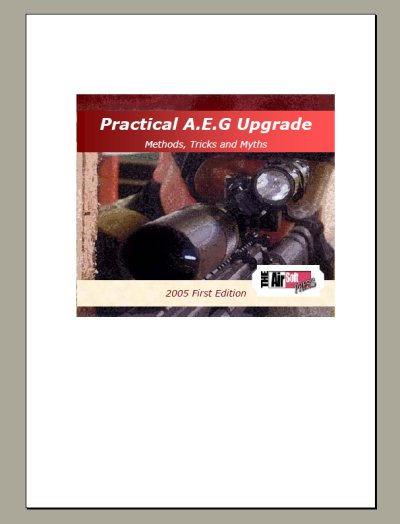
I must admit, although thinking it sounded interesting, it slipped from my mind until someone posted, some months later, praise for the guide.
I got in contact with The Airsoft Press and they kindly sent over a copy of the guide for review.
The Airsoft Press is Hong Kong based and, to use their words :
Members of the AirsoftPRESS editorial team are practicing engineers, technicians and field operators who have been with Airsoft since the era of the S.S. 9000 series and the gas-electric hybrid Jatimatic (W.A. 1986). Being geographically close to the origin of Airsoft enables close contact with the major manufacturers, thus facilitating in-depth and accurate coverage of the hottest "toys of the trade".
Which all sounds promising.
I cannot claim to be an expert on AEGs, but then I am a good candidate for the guide.
Over 100+ pages of PDF document, it sets out to explain what upgrades will do for your AEG, what the practicalities are and what the trade-offs are.
The first section explains, in words and pictures, the key components of an AEG. If, like me, you've never gone further than a field strip with an AEG, those parts on the Hong Kong retailers will make a lot more sense after reading this section.

The next section compares the AEGs of Tokyo Marui, ICS, CA, Academy and Cybergun (As well as some rebranded variations). One thing that quickly struck me as good about the guide was the extensiveness of the brands covered. They do not simply assume you have a TM AEG.
Shimming, use of high torque gears, batteries, springs (different types and makes) and many other issues are covered well in the section on achieving improved FPS from an AEG.
The next sections cover upgrades to deliver great ROF and accuracy, in equal detail and clarity.

The final section is devoted to troubleshooting. This covers such questions as "What will happen with improper shimming?", "What causes gear stripping?", "What needs to be regularly replaced to keep my gun in good shape?" and "My mechbox got stalled after replacing the tappet plate. What’s wrong?". Over the section, it seems to cover a great deal of what might go wrong during an upgrade.
It is possible that you could find all the information contained in the document somewhere online, but I am sure it would not be as coherently presented, consistent (the fault of the internet is that for every opinion, you can find the exact opposite expressed) and would take many, many hours of researching.
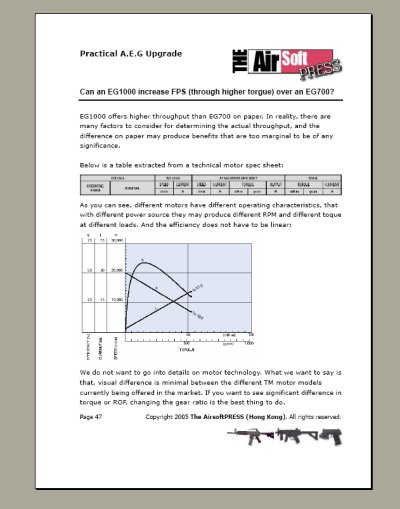
Where needed the words (which only occasionally show the authors' first language is not English) are backed up with annotated photographs and diagrams. Remote weblinks are used at times to provide background information.
Being an Adobe PDF format, the document is easy to search and there is a comprehensive contents section at the front.
Most sections are 1-3 pages long, so there is not much need to read through long sections to find the specific information you need,
but there is no index for fast hard-copy lookup.
The authors are not afraid to say when they consider something a waste of time and some 'conventional wisdom' is challenged (For instance they state that the EG560 is stronger than the EG1000 motor), but they always provided supporting evidence.
Having read this guide, I would consider a lot of the advice given on the forums to be flawed (usually suggestion overly complex upgrades to achieve certain results, which I know to be the case with Gas guns) and the Airsoft Press guide has a ring of experience about its advice that respected forum members command.
The website features an errata section for each publication (there is already a springer upgrade guide for $11.95 and a special guide for the Cybergun AR15 AEG, at $13.95, with more to follow), although there are commendably few.
If I was really looking to be picky, I would say that some of the photographs could be a little clearer and a few more graphics, generally, might make the e-Book
format easier to read online, but you can always print it off (at work?) to have to hand during the upgrade process. An index would also help for hard-copy
searching.
I am also a little unsure about the idea of weblinks to background information. The volatile nature of the web can easily make today's authority a 404 page tomorrow, although it is fair
to say the links are not critical to the integrity of the guide's content.
Overall, for US$22.50 (about £12/18 Euros at current exchange rates), the guide seems great value and certainly demystifies the AEG and the upgrades associated with it. It certainly deserves a wider audience and, from the comments I have received in communication with the Airsoft Press, they are keen to incorporate improvements.
If you want to know more, or buy the guide - Visit The Airsoft Press website.
Guarder and G&G Metal SVI Chambers
If you are fitting a metal slide to a WA (or probably TM or any other) 1911 style GBB, you will soon find (if not even before fitting a metal slide) that the plastic chamber cover (inside the ejection port) takes a pounding.
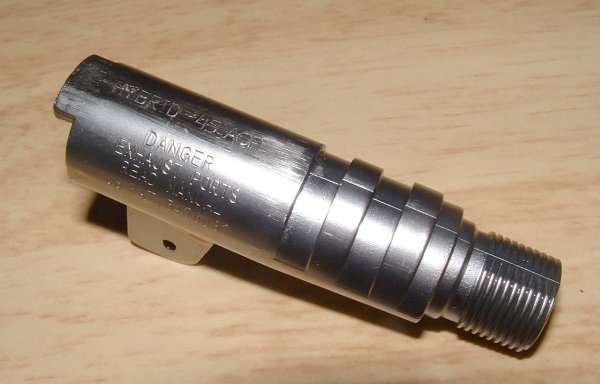
On my SVI 6" Hybrid Comp, this was worn away from use, simply with the plastic slide and, especially next to the shiny Shooters Design metal slide was looking decidedly care worn. Initially, I could not find a metal Hybrid cover with the same patent number as the standard gun, but I did have a G&G metal chamber that I had bought a year or two earlier and never used.
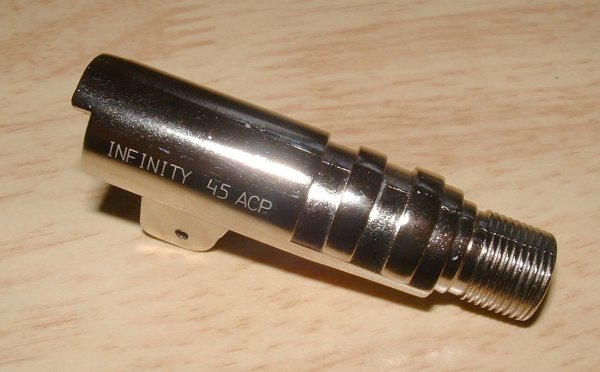
With the outer barrel off, the chamber was easy to remove as it is simply held in with a pin, but there is usually a barrel support, located with two O-rings to be removed before the chamber can be slide off the inner barrel.
Refitting the G&G chamber was quite simple. I needed to slightly widen the holes for the pin, but that was easily achieved with a small jeweller's screwdriver (one of 6 for £1 and indispensible for anyone working on airsoft pistols). I also found I needed to slightly file the back of the two 'legs' of the chamber to let it fit over the chamber/hop-up unit, but this was achieved in a few minutes.
Once fitted, the gun reassembled, without problem and worked straight away.
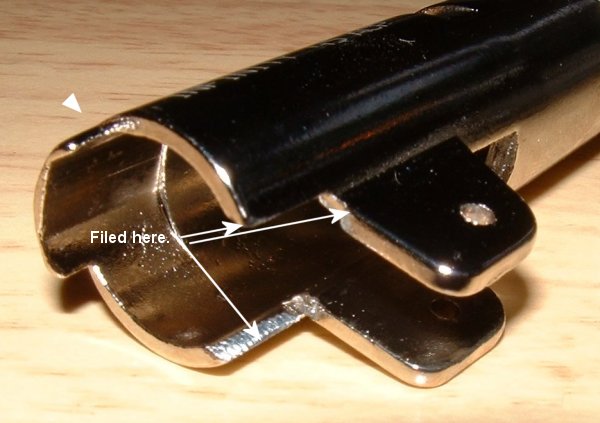
A few weeks later I was directed to a Guarder Stainless Steel chamber at WGC, which had exactly the same markings as the standard WA chamber and I ordered it up.
Comparing the two side by side, it was clear that the Guarder is worth the extra money. It's much heavier and CNC-milled, whereas the G&G chamber is clearly moulded (with seam lines to prove it) and, whereas the G&G is chromed, the Guarder is simply polished to a very realistic shine.
Fitting was, at first, even easier, as there was no filing required to the legs to engage with the internals and the hole for the pin required less cleaning up for the pin to pass smoothly through.

However, with the top end back together, I could not get it to mate to the frame correctly. When the slide was aligned correctly front and back the hole for the slide lock was too far forward.
I was directed to Guarder's website, which suggested a couple of small mods to the frame and slide. There was a slide contact between the new chamber and the frame, but relieving this did not solve the problem.
Taking a closer look, I noticed the rear of the chamber was a fraction of an inch away from the rear of the ejection port - The solution? I wound the outer barrel off one turn and everything suddenly lined up!

For finish, build quality and weight, the Guarder is far superior to the G&G. My silver finish G&G chamber looks a bit cheap and there are noticeable seams on it.
The markings on the G&G are not very good, either, bearing no likeness to the original chamber cover and being very shallow.
However, the chamber was quite easy to fit and will do the job if you are on a tight budget or as a stop gap to replace a broken plastic
chamber.
Whilst the extra $33 ($53 vs $20 at time of writing) represents 150% of the G&G's price, it is well spent on the Guarder chamber cover. Why spoil one of the great airsoft pistols with a cheap chamber, especially if you have already invested in a metal slide.
| Chamber | Price | Weight |
| Standard WA | N/a | 6g |
| G&G | $20 | 27g |
| Guarder | $53 | 39g |
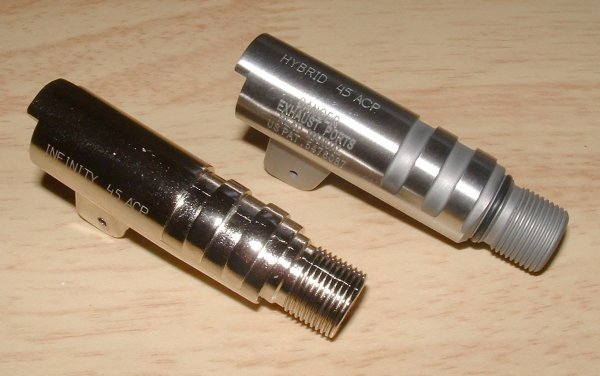
Airsoft Innovations Air Duster Adaptor
Whilst AI's excellent Propane adaptor is a great piece of kit for upgraded and all metal guns, some owners will still not want the extra wear that using high pressure gasses will cause. Some guns, also, are simply not strong enough to cope with prolonged use of such gasses.
For these people, AI have produced the Air Duster Adaptor.
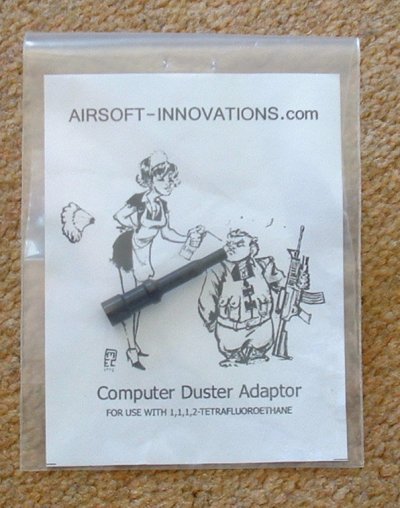
Air Duster is the stuff sold for blowing dust out of computers. Normally it is a gas called "1,1,1,2-TETRAFLUOROETHANE" and most claim to be 100% Ozone friendly, which will appeal to many airsofters.
The Adaptor is a simple, strong plastic nozzle which fits over the outlet on the Air Duster, once you have removed the spray nozzle from the Air Duster (a simple, reversible, lift off process, so you can carry on using the Air Duster for Air Dusting, if you wish).

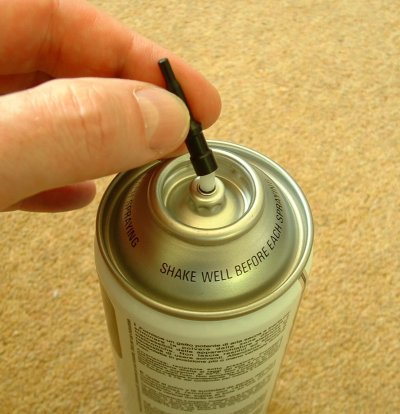
Air Duster spray is pretty cheap in the US ($6 or so from Office Depot Vs $12.95 for branded 134a at Airsplat as I write) and I am told 134a is not always easily found there, but Air Duster spray is not so widely available or cheap in the UK - I paid £9.99 for a 400ml air duster can from Maplins, the same price most UK retailers sell 134a for.
Fitting the adaptor was a doddle and once you have, you can fill your magazines the same way you would with a proprietary airsoft can or the Propane Adaptor.

Filling all the magazines, there were no spills as you see with the Propane adaptor, which is much more sensitive to alignment than the Duster Adaptor is, which I suspect is due to it being metal, rather than the more flexible plastic of the Duster adaptor.
I tested Air Duster with 3 guns.
First I tried it in my Tanaka Luger P08 8". In a test carried out some while ago, Abbey 134a produced an average of 308fps at 20C. The Air Duster produced an average of 291fps at the same temperature - Close enough and the difference could be due to other different conditions, notably the ambient temperature of the magazine before firing.
Next was my Marushin Mauser M712 NBB, testing the two gasses back to back. With Abbey 134a, the gun averaged 271fps at 20C using .2g Excel BBs. With the Air Duster, the average was 270fps.
Finally, I tried my SIIS Desert Eagle 10" back to back on the two gasses. 134a produced an average of 271fps, Air Duster again gave 270fps.
Overall, the results are close enough to say that Duster Gas produced pretty much the same performance as branded 134a.
| Gun | 134a Average fps (.2g BBs at 70C) | Duster Average fps (.2g BBs at 70C) |
| Tanaka Luger GBB | 308 | 291 |
| Marushin Mauser NBB | 271 | 270 |
| SIIS Desert Eagle GBB | 271 | 270 |
Of course, you will need to lubricate more with Duster, as branded 134a like Abbey has silicon lube added,and a drop or two of oil can be put into the tip of the duster can or into the adaptor before pushing the adaptor onto the tip of the duster can. Alternatively, a spray of silicon lube into the magazine top vent, with the valve open, now and then, should do the trick.
Carl, from AI, also observed that the stem on a duster can can be easily broken if you leave the adaptor on (say you throw it in a gear bag). The little stem isn't meant to be pushed sideways so the adaptor should be removed when it's not in use.
If you are wary of using Propane, for whatever reason, the Air Duster Adaptor provides a practical solution, although you should check the relative prices of Air Duster and branded 134a in your location before assuming you can make significant cost savings.
If you are interested in the Air Duster adaptor, you should contact Airsoft Innovations directly.
Guarder WA SVI 150% Uprated springs
These came in a double pack, containing an uprated hammer spring and recoil spring.
The theory is that uprated hammer springs impart more force to the hammer, which hits the gas release valve harder, releasing more gas. This, if the theory follows, produce some more power AND overcome any issues of light strikes with higher pressure gasses, where the pressure in the magazine is too great for the hammer to overcome with the standard spring.
As you can see here, the Guarder spring (on the left below), claiming to be 50% stronger than the standard one is made of slightly thicker wire and is longer.

Fitting it was pretty easy, requiring nothing more than the removal of the mainspring cover pin and mainspring cover and then the small pin holding the spring and spring cup inside.
Swap the springs and reverse the process and, heh-presto, an upgraded hammer spring in about the time it took to read this, and certainly less than it took to write.
Sadly, the results were disappointing. The Wilson Hi-Capa I fitted it to produced around 293FPS with the standard spring. With the uprated spring, it averaged out at 295FPS which is no difference at all.
Onto the recoil spring. The Guarder version (shown lower, in the picture below) is a very bright chrome metal and around half an inch (13mm) longer than the standard spring. Upgrading requires a simple field strip and swapping the springs over.
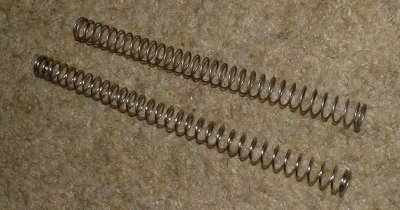
Even refitting the recoil spring and rod, it was quickly apparent that there is considerably more pressure require to compress the spring and to the eye the return to battery (most rearward position of the slide back to rest) phase of the cycle is noticeably faster, although, even with a metal slide fitted, the Wilson Combat in standard form is no slouch in this respect.
Looking at wave file profiles of a shot from the gun with the standard spring and then the updated one, shows a difference in total time from beginning to end of 3/100s of a second (.104 second to .076 second), with the return to battery phase, where the spring is working, reducing by almost 50% (.047 second to .026 second). Whether you need such an increase in performance is debatable, especially with WA SVIs where metal slides are around the same weight as a standard one and the standard spring will cope happily.
However, the recoil spring, clearly, does the job it is expected to and some practical pistol shooters will welcome any speed advantage they can achieve.
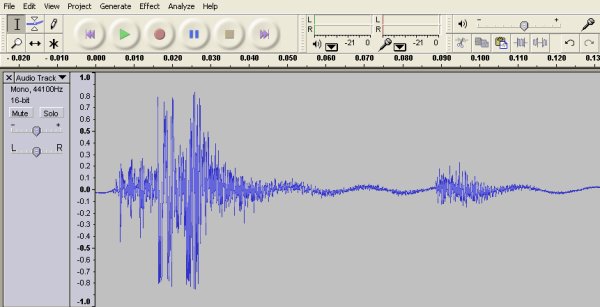
Shot with the standard WA recoil spring.

Shot with Guarder 150% uprated spring.
Airsoft Innovations Flow Restrictor
I actually received this some months back along with the Propane Adaptor, but had always hesitated to fit it, because it requires a permanent modification to the internals of the gun. Having obtained a spare one of these parts, I set to trying it out.
The idea of the flow restrictor is simple. The issue with using Propane in standard WA guns is, often, that the force of the slide being 'blown back' is so great that it can, in time, crack the slide. The solution from AI is to restrict the amount of Propane which is directed to the blow back part of the firing action, by providing a smaller hole for the gas to pass through.
AI send the flow restrictor (a tiny sequin like piece of metal - see inset), in a CD box with a CD which contains a number of detailed videos showing how to fit the restrictor to Magna R or SCW 1911s, SVIs, Para Ordnances and their variants (I can confirm it will not fit WA's Beretta 92s, although it is said, by AI, to fit the Cougar).
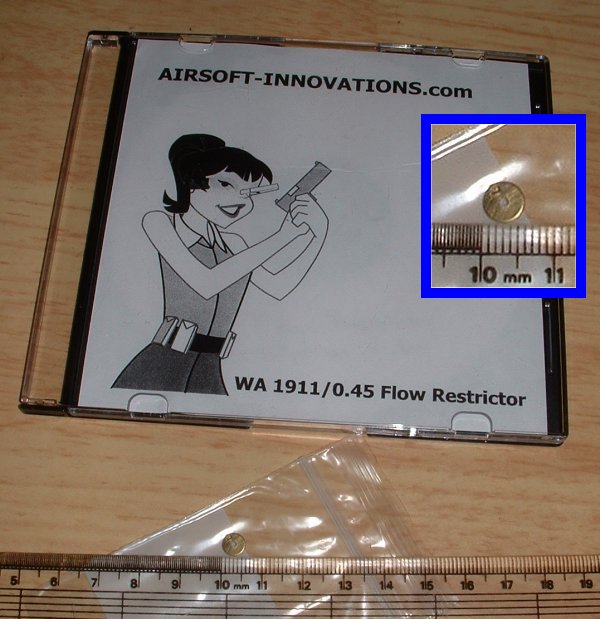
As long as you are methodical in your approach and careful when disassembling the gun (careful not to lose small parts), fitting the restrictor should pose no problems to anyone and the videos provided are impressively clear and thorough. If you're unsure you are up to the work required, you can see the videos on Airsoft Innovations' website, before taking the plunge.
I am fairly used to messing with gas guns, so had no problem getting to the point of fitting the restrictor and it was easy to press fit the restrictor in, the effect of which can be seen below.

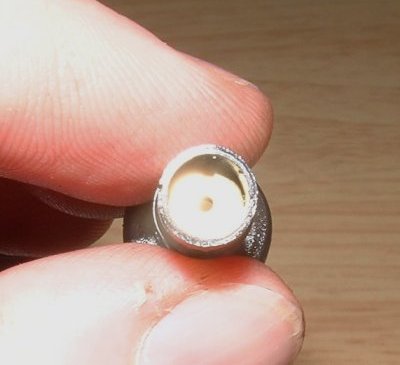
So, did it work?
I fired the gun, without the restrictor with Propane and saw around 300 fps. Having fitted the adaptor, the gun produced identical velocity, so the reports I've seen, on some forums, saying the flow restrictor causes a gun to 'perform like 134a is being used' are false.
I measured the cycle time with and without the restrictor and there appears to be virtually no difference (maybe a couple of thousandths of a second, which I consider unmeasurable). Certainly the FORCE of the kick, subjectively, feels less fierce and I would say, without replicating AI's extensive testing ( well documented on their site), that the blowback force is reduced to a level around the same as with 134a on the unrestricted gun.
With the SVI 6" Single stacker I fitted the adaptor to, the gun was still able to cycle reliably through a full 15 round magazine using 134a at around 18C, but the action was weak and I would expect to see problems at temperatures much below that on weaker gasses, but that is no surprise, AI do not suggest you use 134a once you fit the flow restrictor.
So, it seems to do what it claims (something I have come to expect of AI's products), although time will tell if the flow restrictor reduces wear using Propane/Green Gas to 134a levels or whether it remains somewhat higher.
The biggest downside I can see is that you will probably have to permanently modify the floating valve, which will prevent you reverting to 134a usage, except in warm weather.
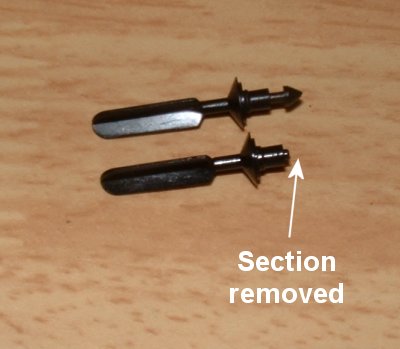
However, if you will never go to 134a again OR you can find a spare part (they are very cheap if you can - I paid £4 for the one shown and £5 for a brass replacement unit), then that problem becomes a moot point.
A metal slide is probably still the preferred choice, but if you cannot source one or want a cheaper option in the short to medium term, the flow restrictor seems like a perfectly workable alternative.
Full information is available on Airsoft Innovations' website, where you can also order the flow restrictor.
The Airsoft Press Gas Airsoft Handgun Upgrade & Maintenance Guide Vol. 1
Last year, I received The Airsoft Press AEG Upgrade Guide and thought it a very good publication for anyone considering upgrading their AEG.
However, my knowledge of AEGs is limited, so I was very interested to see that The Airsoft Press were planning a gas gun version, as I felt I could bring more knowledge to my review of this publication.
Mike at Airsoft Press sent me Volume 1 of the Airsoft GAS Handgun Upgrade & Maintenance Guide over Christmas (2005) and I have had a chance to read through it now.
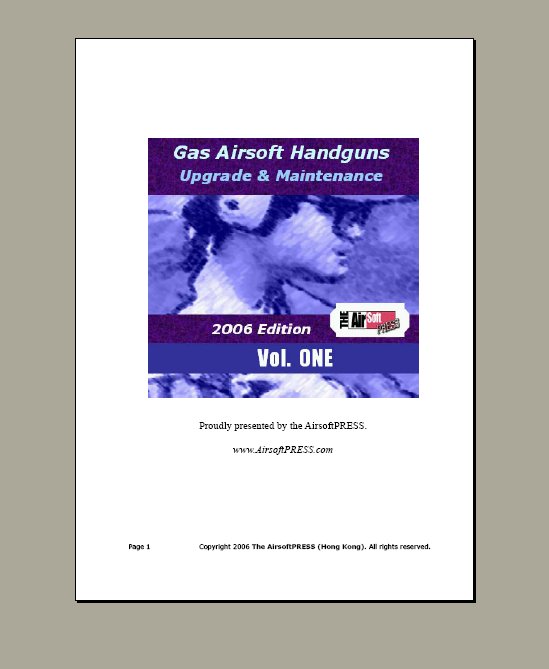
Once again, the guide sets out to cover a lot of ground, but as it states early on this is not as exhaustive a guide as the AEG guide was.

Where the AEG guide covers all the theory and most of the practical aspects of upgrading an AEG, Volume 1 of the Gas Gun guide is more of a thorough grounding in the theory of gas guns and how this affects the practical aspects, but contains little 'how to' information.

The theory aspect, however, is covered excellently and exhaustively. I have never seen the gas blowback system's operation described so clearly or in such depth and it even covers CO2 pistols operation, with annotated diagrams and plenty of understandable explanatory text.
Subjects such as types of gas, effectiveness or otherwise of tightbore barrels and hop-up are all covered in the same way.
The guide is delivered as a PDF document, which means searching is easy and you can read online or print out as suits you.
At a very reasonable $12.95 (£7.5/11 Euros or so - Less than the price of a can of gas in the UK), the Gas Airsoft Handgun Upgrade & Maintenance Guide Vol. 1 forms an excellent introduction or reference (don't think you know too much to make this superfluous) guide for anyone considering upgrading a Gas airsoft handgun, exploding some myths along the way (as the AEG guide did), but for people looking for practical guidance on how to upgrade a gas pistol, we will have to wait until Vol 2 is released (scheduled for July 2006) before the practicalities are addressed.
If you have an interest in gas guns, Vol 1 makes a sensible buy on its own, but if your interest is driven by a desire to get stuck in on a gas gun upgrade, you might be better served to wait until Vol 2 is also available.
As well as the Gas gun guide, I also received an updated version of the excellent AEG Guide and there a number of other guides, including Spring upgrade guide and specific model upgrade guides (for guns such as the MP5 range, Armalites, etc) - You can find full details and buy from The Airsoft Press's website.
The Airsoft Press Practical Tactics Guide for Airsoft
As well as their AEG (and now Gas gun) guides, AP sent me a copy of their Practical Tactics guide.
The guide covers Airsoft Vs Real Combat differences, Airsoft handling safety, Carry positions, Basic rifle marksmanship skills, Combat firing, Target detection, Cover and Concealment, Tactical Movement and Fighting in the dark, with appendices on Sniping and Breathing control and aiming.
My initial thoughts were that the guide provided some useful guidance to someone like me (with zero experience), but not being a skirmisher, I passed it onto "Wege", who has provided a few reviews for this site and is an experienced skirmisher, for his comments.
In the section on Carry and Guard positions, some of the shots, notably the kneeling position were not that clear. The shots with the 'model' in the T-Shirt are admirably so, but the camouflaged shots are too effectively camouflaged for true clarity. There were also position not covered with an image.

A notable absence in any form is reference to pistols. Some skirmishes are pistol only and a section on using airsoft handguns would have been a welcome addition.
Wege added :
"The guide comes over as a mixture of airsoft and real firearm information, although they address some of the difference in a section up front, but
the size of a human is at 175 yards in relation to a M4/M16 front post sight isn't relevant to airsoft. it would have been more informative to
have had someone standing in front of that sight, at 10m, 25m and 50m, and pictures of them.
"Something else handy would have been a silhouette made of other variants of how a sight picture should be such as those found on the AK, SIG552, MP5, UMP: the common AEGs found.
"Real world Suppressive Fire is closer to a rate of about 1 round every 5-10 seconds or so. What is being implied is either heavy fire, or rapid fire. The use of team-mates, though, is a good call.
"The sniper call is good, too, as they should be used as an observer.. particularly if there is a major OP with impressive FOV.
"Since torches are mentioned, perhaps some models could have been specified as a possible choice.
"Overall, this is a reasonable consolidation of material that is mostly freely available from the internet, but I don't feel it is worth the $16.95 US.
It is good to see that there are 'updates' available, but I would prefer to have seen more specific recommendations on products (and why recommended) , as well as the continuity of layout for clarity (particularly with reference to poses and model-usage). I would have liked to have seen the professionalism bumped a bit too as there is absolutely no need for profanity to have been used in any context at all.
"Perhaps also some 'add-on selling' could have been done as well, with some teaser information of some of the general detail, and then saying that an in-depth look will follow. An example would be for camouflage, which really was only touched on lightly.
A nice effort but it fell short for me."
Wege makes some very good points and I am sure many experienced skirmishes will find areas where any guide could be improved upon, but if you are new to skirmishing and want a concise introduction to skirmish tactics, you will probably find the Airsoft Press Practical Tactics Guide a good place to start and £10 or so is not much money in terms of the typical airsofter's spend.
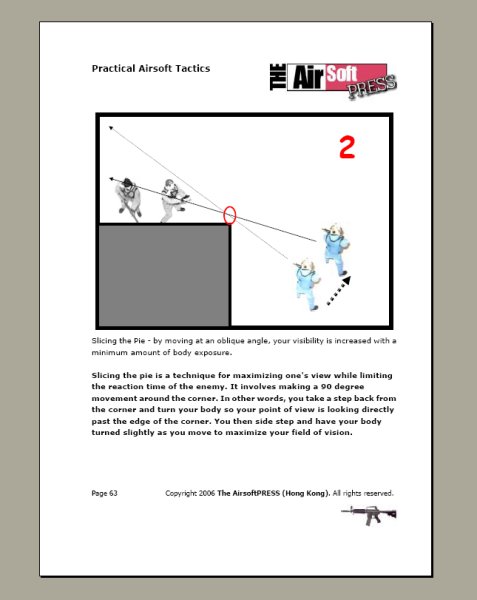
For my part, I particularly liked the diagrams (one shown above) in the section on Tactical Movement. Using the PDF viewer, they effectively work like an animation as you skip forward through pages. Whether this was deliberate or not, it works well in getting the ideas across.
One aspect that struck me, and may be difficult for the team in Hong Kong to address, related to the environment. Spotting targets and camouflage will pose quite different challenges in Northern European woodland or SOCAL brush than the dense Asian jungle. If they could find people to write on these aspects from different regions too, the information would be more universally applicable.
So, overall, this edition is probably not a 'must have' for the experienced skirmisher, but a useful consolidation of material for the less experienced.
A second edition, with the poorer images replaced, more focus on original material dealing specifically with airsoft specific engagement ranges and some expansion in a few other areas, though, could be a winner.
Update - March 2006
Mike from AirsoftPress got in touch to say:
"we have updated the Airsoft Tactics guide with many airsoft specific info, the current release version is 1.5. "The next major release (which is Ver 2.0) is in the work. It will incorporate most of the inputs you have provided us last time. I hope to get it ready by the coming May."
There are some useful additions already in V1.5 and all buyers are eligible for free life time updates on the guide they purchase, which is about as fair as you can get, I'd say!
Back to the Homepage